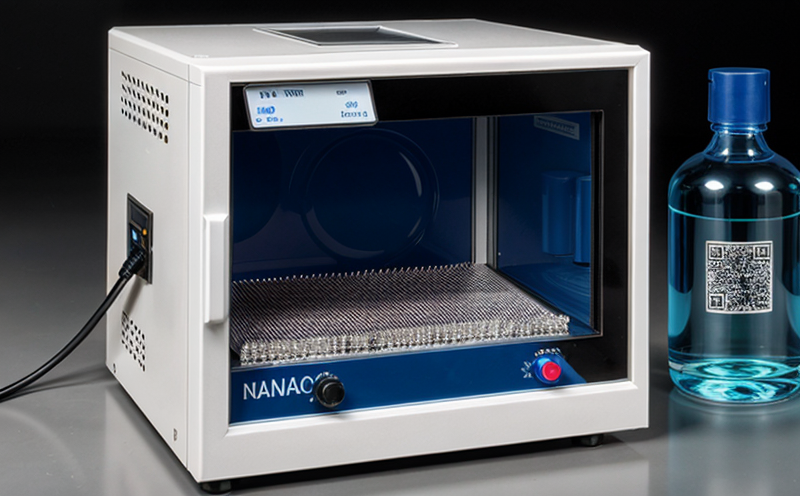ISO 19430 Nanomaterial Reactivity Testing
The ISO 19430 standard provides a framework for assessing the reactivity of nanomaterials, which is critical in ensuring safety and preventing potential adverse effects on human health and the environment. This service involves comprehensive testing to evaluate the chemical behavior of nanoparticles under various conditions. Understanding how these materials interact with their surroundings can help in minimizing risks associated with their use.
Reactive nanomaterials are those that exhibit chemical activity when exposed to specific environmental conditions such as moisture, temperature fluctuations, or biological interactions. The reactivity testing outlined by ISO 19430 is essential for industries dealing with advanced materials, including electronics, pharmaceuticals, and cosmetics. By conducting rigorous tests, laboratories can provide data on the stability of nanomaterials in different scenarios.
The testing process begins with careful sample preparation to ensure that the nanoparticles are representative of those found in real-world applications. Once prepared, these samples undergo a series of standardized tests designed to measure their reactivity. Key parameters include particle size distribution, surface area, and functional groups present on the nanomaterials.
Standard ISO 19430 protocols cover several types of reactivity assessments such as dissolution rate testing, oxidation-reduction potential measurement, and pH stability evaluation. Each test aims to reveal how quickly or slowly a particular type of nanoparticle reacts with its environment under controlled conditions. This information is crucial for predicting the behavior of nanomaterials in various industrial processes.
One of the most important aspects of this testing is ensuring consistency across all stages from sample preparation through final analysis. Laboratories must adhere strictly to international standards like ISO 19430 when performing these evaluations. Compliance with such stringent guidelines ensures reliability and accuracy, which are vital for making informed decisions about nanomaterial usage.
Understanding the reactive potential of nanomaterials allows manufacturers to develop safer products while also complying with regulatory requirements imposed by governments worldwide. For instance, EU regulations mandate thorough evaluation before approving new nanotechnological applications. Therefore, implementing ISO 19430-compliant reactivity testing becomes not only advisable but mandatory for many companies operating in this space.
- Sample preparation: Ensures that the nanoparticles used in tests accurately represent those found in actual products.
- Dissolution rate testing: Measures how quickly a nanoparticle dissolves in water or another solvent over time.
- Oxidation-reduction potential measurement: Determines whether a nanomaterial can participate in redox reactions with other substances.
- pH stability evaluation: Assesses the ability of a nanoparticle to maintain its chemical properties within certain pH ranges.
By offering ISO 19430-compliant reactivity testing services, we aim to support our clients in meeting their stringent quality assurance and regulatory compliance goals. Our team of experts uses cutting-edge technology and methodologies to deliver accurate results that provide valuable insights into the behavior of nanomaterials.
Why It Matters
The importance of ISO 19430 Nanomaterial Reactivity Testing cannot be overstated, especially given the growing interest in utilizing nanotechnology across diverse sectors. As nanomaterials find their way into everyday products like sunscreens and electronics, understanding how they behave under different conditions becomes paramount.
Reactive nanomaterials pose unique challenges due to their small size and large surface area, which can lead to increased reactivity compared to bulk materials. This heightened reactivity might result in unintended side effects if not properly managed. For instance, certain nanoparticles could potentially leach into the environment or cause irritation when incorporated into consumer goods.
Implementing ISO 19430 testing helps mitigate these risks by providing detailed data on nanomaterial stability and reactivity. This information enables manufacturers to design safer products while also ensuring compliance with relevant regulations. Regulatory bodies worldwide recognize the significance of this standard, making it a requirement for many industries.
Moreover, ISO 19430 testing supports research efforts aimed at developing new nanoformulations that balance efficacy with safety. By offering reliable reactivity data, laboratories contribute to advancing knowledge about nanotechnology's role in sustainable development and public health.
In summary, ISO 19430 Nanomaterial Reactivity Testing plays a crucial role in promoting responsible innovation within the realm of nanotechnology. It ensures that emerging technologies are developed thoughtfully and responsibly, thereby fostering trust between producers and consumers alike.
Applied Standards
The ISO 19430 standard is widely recognized as a comprehensive guide for assessing the reactivity of nanomaterials. It covers various aspects ranging from sample preparation to reporting requirements, ensuring that all testing processes follow internationally accepted practices.
- ISO 19430-1:2018: General principles and definitions related to nanomaterial reactivity assessment.
- ISO 19430-2:2018: Guidelines for sample preparation of nanomaterials intended for reactivity testing.
- ISO 19430-3:2018: Methods for measuring dissolution rates of nanomaterials during reactivity testing.
- ISO 19430-4:2018: Procedures for determining the oxidation-reduction potential (ORP) changes in nanomaterials undergoing reactivity tests.
These standards ensure that all laboratories conducting ISO 19430-compliant testing follow consistent procedures, leading to more accurate and comparable results. The use of these internationally recognized guidelines strengthens confidence among stakeholders involved in the development and regulation of nanotechnology applications.





